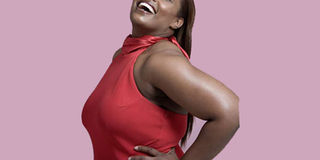The rise of the curvy woman

You must have noticed the rise and rise of the curvy woman. She looks nothing like what we have been trained to see on runways. PHOTO | FILE
What you need to know:
- Depending on who you ask. A decade back, it was sizes 12 to 18, according to PLUS Model Magazine. In the UK plus size begins at size 18. Note that US and UK sizing is different. UK sizes are larger.
- The US prefers vanity sizing, the science of making numbers appear smaller than they are so people can feel better about themselves. It’s why the US has size 0. A UK 18 is a US 16. Australian sizes also vary.
- Plus size is still an ongoing conversation, but it is evident the women and the public are winning, and fashion, if it does not step up, will be seen as a sulky, overgrown child.
You must have noticed the rise and rise of the curvy woman. She looks nothing like what we have been trained to see on runways. With rounded hips, fuller buttocks, soft belly, full breasts and solid thighs, she is stunning. The plus sized model is getting applause as she smiles where the 34-24-34s pout.
Her step is sound and unexpected, an amazon standing at 5 foot 9 and above. She is just as easily fat shamed as she is celebrated. She will have none of the former. She stood in the shadows for too long, told she was not the right size. That she should whittle herself down to half her own size.
That clothes don’t come in her size. That she is not attractive and cannot be sexy. That fashion has no room for her ‘kind’ because she committed the greatest faux pas ever: she is bigger than a size 8; the average size of an American woman in 1985! Which has since grown to a size 14.
She cannot be accommodated because she spills out of the well sketched, beautifully designed, contained lines the fashion industry has built itself upon. Except fashion overlooked one critical thing. There’s more of them, these women who demand more, than there are fashion insiders. Slowly, they have pushed past neat lines and burst it at the seams.
But first, what is plus size?
EYES OF BEHOLDER
Like anything else in life, it depends on who you ask. A decade back, it was sizes 12 to 18, according to PLUS Model Magazine. In the UK plus size begins at size 18. Note that US and UK sizing is different. UK sizes are larger. The US prefers vanity sizing, the science of making numbers appear smaller than they are so people can feel better about themselves. It’s why the US has size 0. A UK 18 is a US 16. Australian sizes also vary.
Locally, years back designer Lucy Rao mentioned the average Kenyan woman was a size 16.
Regardless of measurements, an NPD Group research says that 63 per cent of plus size women want to buy what their smaller friends wear, and 80 per cent of plus sized women felt uncomfortable shopping.
Small wonder considering clothing stores like Zara and Topshop haven’t jumped at the opportunity to dress this demographic.
Keep in mind plus sizes were worth $17 billion in 2014 and growing. This includes teens and junior categories.
Catering for the plus size is increasingly a business decision that could make financial sense. Research firm Mintel says as women grow older, they tend to grow larger such that a quarter of women aged 55 and above are plus sized.
And the older a consumer grows the less likely they will want to shop online, and will demand the full shopping experience. At the same time they dislike shopping because they have to try out clothes that come in a limited selection that make them feel bad about themselves.
Women want clothes cut to fit and accommodate their bodies as opposed to making smaller designs simply bigger. They want to feel sexy, attractive and beautiful.
Between January 13 – February 3, Beyond Measure: Fashion and the Plus Size Woman was the feature of the theme of The Masters of Arts candidates in New York University’s Visual Culture: Costume Studies Program. They took the opportunity to use this annual exhibition to explore the conversation around the “plus size woman in relation to fashion and the body.”
DARK SIDE
Their perspective was locked into how the fashion industry has contributed undeniably to the stigmatisation of women with larger bodies. It traces a history of plus size through the centuries from a time when bigger was fetishised and skinny women were found as unattractive, prompted to go through some sort of fattening experience, to the current state of affairs.
Plus size is still an ongoing conversation, but it is evident the women and the public are winning, and fashion, if it does not step up, will be seen as a sulky, overgrown child.
There is a dark side to plus size that keeps cropping up, and that is health. It is presumed big is unhealthy and should therefore not be celebrated especially with obesity rates growing globally.
All I know is skinny models have died from health issues like anorexia while the plus size models I have met and interviewed locally seem to enjoy healthy lives. Which, unfortunately, is more than I can say for the size 2 to 4 models.





